I know what you’re thinking. Joe From Cincinnati has joined some website that posts articles, videos, podcasts and blogs about A Game of Thrones LCG 2.0 Edition? I wonder what his first article will be about.
Well, wonder no longer, as I have decided to take the path less traveled and talk about…the Night’s Watch!
Now that you have awoken from your swoons of disbelief, I’d like to go over a few things with the Night’s Watch. And I believe this article will serve as a basis for other articles discussing the different factions and where they stand, so I may as well include a handy little outline of what I’ll be doing here:
- Introduction to the Night’s Watch
- Core Strategy
- Strengths
- Weaknesses
- Ideal Banners
- Preferred Plots
- A Look Ahead
Obviously, as the card pool expands, these things will be adjusted. This article is written with the core set and the first chapter pack, Taking the Black, in mind. I will briefly mention future cards that have been spoiled for the first chapter pack cycle at the end of the article, but the main focus will be on what you can build today.
And, as a special treat, since this is my first actual article on this website, I will begin with a small introduction to who I am and why you should care (though you probably shouldn’t).
Introduction to Joe From Cincinnati
For those that do not know who I am, my name is Joe Habes. I live in Cincinnati, OH and my local game store of choice is Arkham House Games. Our local Game of Thrones LCG night is Wednesday from ~5pm to when the owner, James, kicks people out. I have a Youtube channel where I post OCTGN games and, hopefully in the near future, recordings of real card games. I’m very active on the Cardgamedb.com forums, where I try to convince people to play Night’s Watch decks more. I do the same in the Game of Thrones LCG 2.0 Edition Facebook Group. I’ve also worked with ThroneRunner, another Youtube personality, who I introduced to the Night’s Watch (specifically, my Night’s Watch Banner of the Wolf deck.) And, if it weren’t for their ban on women and lands, I feel he would have joined full on by now. He’s still an Ironborn, as of today, but he’ll get there.
I’m all about the underdog and I tend to intentionally avoid playing the meta defined top tier decks in any game I play. I don’t know why. Maybe I just have no aspirations to ever succeed in a tournament, but that’s just always been how I play my card games.
For those reasons, you’ll see me gravitate towards the Night’s Watch primarily. We’ll talk about why I like them in this article. I also enjoy playing Tyrell and Martell decks. I’ll throw in the occasional Greyjoy deck as well.
Introduction to the Night’s Watch
Now that we’ve gotten that out of the way, it’s time for the reason you opened this article. To read about the Night’s Watch.
I believe there are different kinds of players in all card games. I’m not talking about Ned/Jaime/Shagga (or, for you Magic players, Johnny/Timmy/Spike). I’m referring more to general playstyle. You’ll run into players that love imposing their will on the board; they love to be proactive. These players like to play high aggro decks like Greyjoy, Targaryen, Stark and, under certain circumstances, Tyrell. Then there are players who prefer to see how the board state develops and adjust their strategy accordingly; they like to be reactive. These players typically like to play control decks that allow them to react appropriately to what their opponent does, like Baratheon, Lannister and Martell. Obviously, few players are 100% proactive or 100% reactive. Each faction has elements of proactive and reactive gameplay, giving the players the flexibility to play within their comfort level with whatever faction they prefer. It is generally a sliding scale between the two, and a player will fall somewhere along that line.
However, much like the brothers on the Wall compared to the rest of Westeros, the Night’s Watch does not fit perfectly in with the rest of the factions. They don’t have any interest in imposing their will on their opponent, nor are they particularly interested in reacting to their opponent. Just as they are in the books and TV show, the Night’s Watch prefers to simply withstand their opponent, rather than try to impact them in any way. And with that, I will segue into what the Night’s Watch’s core strategies are.
Core Strategy
As I alluded to in the introduction, the Night’s Watch does not try to control their opponent, nor do they try to impose their will on their opponent. The main strategy in Night’s Watch revolves around a few key cards:
These 4 cards combine to form a strategy that is unlike any other in the entire game. With the exception of whatever banner you may bring into your deck, the Night’s Watch has no efficient way of stopping your opponent from winning challenges, claiming renown or using their abilities. The only job of the Night’s Watch is to survive.
If you can oppose all challenges initiated by your opponent, you can use The Wall to claim 2 power for your faction. Castle Black allows a character to stand after defending a challenge, meaning you don’t need many brothers to accomplish the goal of opposing all challenges initiated by your opponent. Maester Aemon allows you to kneel him in lieu of killing one of your precious defenders. And Benjen Stark allows his brothers to not be bypassed by stealth, a key strategy for getting around The Wall. Benjen also gains power for his faction when he dies, and is shuffled back into the deck rather than going to the dead pile.
There are other ancillary pieces in the faction, such as Will, Samwell and the Messenger Ravens, which give the Night’s Watch ample draw, A Meager Contribution, which helps the Night’s Watch overcome their lack of funding from the rest of Westeros and, of course, the brothers of the Night’s Watch that help defend those 4 core cards. But all those pieces would be nothing without the core strategy.
Strengths
The biggest strength about the Night’s Watch is their simplicity and reliability. This may sound odd when speaking about a faction that does not win many tournaments (yet). What I mean is, you can always count on the core strategy to work, regardless of what your opponent is doing. If you can oppose all 3 challenges and have the Wall, you will win most of your games.
In all 7 other factions, you need to win challenges in order to win the game. You need to win power challenges to gain power, military challenges to control the board and intrigue challenges to control your opponent’s hand. This is simple in concept, but it is very opponent dependent. In order to win challenges, you need to have more strength than your opponent, meaning your strategy can be completely short circuited if your opponent gets more key cards than you did.
In Night’s Watch, you don’t need to win a single challenge to win the game. Your opponent can have every character and location they want on the board. If you have the Wall and enough characters to defend it, you are going to be, at the very least, keeping up with them and ideally outpacing them as well. This consistent stream of power gain can be augmented further with neutral cards, such as the Iron Throne, as well as banner faction cards, which we will cover in a second.
Weaknesses
Obviously, the weaknesses of the Night’s Watch are based on the inability to get those 4 key cards out (especially the Wall), having it destroyed, or being unable to use its ability.
There are several ways for an opponent to accomplish one of the three things above. This article is already getting too long, so I won’t go into every single one of them, but key things to look out for are kneel, stealth and character removal.
Kneel and stealth are pretty straight forward, but character removal is a pretty broad term, so let’s look into that a little bit.
There are several ways character removal can affect your challenges. And many factions have a good way to generate character removal. For example, Martell has Confinement and Areo Hotah to ensure unopposed challenges, Targaryen has Dracarys! and Plaza of Punishment, Stark has Ice, Lannister has The Things I Do for Love (as well as treachery to stop Castle Black or the Wall itself), Greyjoy has Balon and The Kraken’s Grasp, Tyrell will have Mare in Heat at some point in the future. And, of course, every faction has access to Put to the Sword. Each of these cards can create an opportunity for an unopposed challenge where there was none previously. Always check your opponent’s gold (Or fealty!) before considering your defenders, as an inopportune Dracarys can really mess up your defending strategy.
Ideal Banners
When considering banners for a Night’s Watch deck, there are a few things that you want to look for.
The number one priority is defensive capability. You want a faction that can provide either efficient characters who can help defend the Wall without stunting your already weak economy, such as the Arbor Knight of Tyrell, who costs 2 gold but has both a military and an intrigue icon, or characters/events that make defending the Wall easier. A good example of a character that makes defending the Wall easier is Maester Caleotte from Martell. He can defend an intrigue or power challenge and then, if he loses, remove one of your opponent’s other icons, maybe preventing them from winning or even initiating a certain challenge type. Stealth is also a good trait to bring into the faction, to help prevent unopposed challenges via stealth.
Next thing you want to look for is any alternative route to gaining power. Examples of this include Sansa Stark of Stark or the Chamber of the Painted Table of Baratheon. The truth of the matter is, you’re not going to get the Wall every game. That isn’t how card games work and you’ll be forced to win under non ideal scenarios in some cases. Characters like Sansa or locations like Chamber of the Painted Table do well to help provide consistent power gain to the faction without requiring the Wall every single game.
The final thing you want to look for is any form of protection from undesirable abilities or events. Stark can provide Bran Stark, who can cancel events (and he can’t be cancelled by Hand’s Judgement), or Lannister’s treachery can prevent strong abilities from triggering.
For these reasons, the ideal banners for the Night’s Watch are Banner of the Wolf, Banner of the Sun, Banner of the Stag and Banner of the Lion. Each provides their own unique advantages.
Banner of the Wolf allows you to run Sansa for power gain, Arya for card advantage and stealth (both defensive and offensive), Bran for cancelling events and Tumblestone Knights for efficient bicons. You can also, if you’d like, add Eddard to your deck for additional protection that is immune to kneel, as well as renown for some additional power gain.
Banner of the Sun provides Maester Caleotte and Confinement for icon removal to control the challenges phase, Edric Dayne for stealth(both defensive and offensive), Obara Sand for kneel proof power challenge defense, House Dayne Knight for an efficient bicon and the Palace Spearman for an efficient bicon/tricon. They also have a new card that is about to come out; Nymeria Sand. I’ll bring her back up at the end of the article.
Banner of the Stag provides Chamber of the Painted Table for power gain, Ser Davos for card advantage and stealth (both defensive and offensive), Mel and her R’hllor cards for kneel to facilitate defending challenges and the Bastards in Hiding and Vanguard Lancers for efficient bicons.
Banner of the Lion provides the Hound, the Gold Cloaks and Burned men for stealth resistant defenders (you can use ambush after your opponent declares their stealth targets), the Lannisport Moneylenders for more economy, Tyrion for more gold and stealth (both defensive and offensive), and Treachery for protection from undesirable abilities triggering.
They are ordered in accordance with my preference for them, Stark being my favorite of the 4 banners, and Lannister being my least favorite (though still very good). Obviously, these are not the only options when it comes to bannering these factions; they are just my personal preferences for what that faction offers that is more beneficial to the Night’s Watch.
Preferred Plots
This section is very subjective, as many people will tell you different things based on their play style and which banner they have chosen. But I’ll try to cover your top…let’s say 12 choices.
A Feast for Crows
In a deck that relies on consistent power gain, via dominance, the Wall and Sansa/Chamber of the Painted Table, Feast for Crows is a welcome addition. It has high gold and can gain you 2 additional power if you win dominance. It has low initiative, but in order to win dominance, you probably won’t be attacking with many characters anyway, so going first won’t be a big problem. It works very well with Iron Throne and, when you have Samwell out as well, the reserve is raised from 4 to 6, making it very manageable and even possible on turn 1 with the right set up.
A Game of Thrones
This plot will be heavily dependent on what banner you choose. The Night’s Watch does not have the greatest intrigue presence, but if you banner in Martell, Baratheon or Lannister, you can bring in a lot of intrigue strength, which would make this plot essentially shut down the challenges phase if they can’t win an intrigue challenge. Very good plot for defending theWall.
A Noble Cause
I only mention this plot because I run it in my NW Stark deck and I absolutely love it. Most disagree with me, but when I can bring in Sansa, Arya and Bran from Stark, it gives me about 12 to 13 lords in a 60 card deck, including 2 Littlefingers and 1 or 2 Old Bears/Eddards. In banners that don’t offer as many lords or ladies, this may not be as worthwhile. 7 gold can buy a lot in one turn.
Building Orders
This card is great for finding the Wall early. It isn’t a must include, as a lot of people believe. But it is a nice addition to a plot deck if you have 6 and are not sure what to add to fill out your plot deck. Good gold and good reserve paired with a strong effect can make this a turn 1 “grab the Wall” plot, if your set up allowed you to defend all 3 challenges. Or even if your set up didn’t. It’s never too early to start planning to defend the Wall.
Calling the Banners
If there is one thing Night’s Watch lacks, it is economy. This helps with that. The high initiative and good reserve just make it an all around solid, if unspectacular, plot.
Calm Over Westeros
There are a lot of heavy military decks out there, with Targ/Lion and Greyjoy being the main culprits. This plot gives average initiative but good gold and the ability to either protect your hand, your characters or your power tokens, depending on the stage of the game or the value of the cards either on the board or in your hand. Never a bad inclusion.
Confiscation
A lot of Night’s Watch characters have the text “No attachments except weapon.” But Old Bear and Benjen do not, nor do any characters you bring in from your banner, such as Sansa, Maester Cal or Melisandre. Removing a milk can win the game, especially if it is on Benjen. You can also use it to remove Seals of the Hand, which are a big pain for characters such as Tywin or Balon.
Filthy Accusations
There are a lot of threats in this game. And being able to kneel one of them and not having to deal with them for a round can end up winning you the game, especially if that kneel will allow you to activate the Wall that round when you typically would not have been able to.
Fortified Position
This is a dangerous plot to play, because you have some very valuable text of your own, such as Benjen’s recursion and Aemon’s saves. But it can also blank renown for a turn, or make Balon a mere mortal for a turn as well. It can really win a lot of games, especially ones where you’re struggling to deal with a lot of stealth against a Greyjoy deck.
Here to Serve
Maester Aemon, as stated before, is one of the 4 most important cards in the entire faction, so being able to bring him to the table at will is a very powerful effect. If you’re bannering a faction like Martell or Baratheon, you have some very good targets to include as well in Maester Cal and Maester Cressen.
Jousting Contest
This is another solution to stealth if you are uncomfortable running Fortified Position. This allows only 1 stealth per challenge, as they can only declare one attacker. This could be the difference between defending the Wall and losing it for that turn. This also makes it more difficult for your opponent to win challenges by 5 or more, keeping those Put to the Swords, Put to the Torches and Supports of the People in their hand for the turn.
Wildfire Assault
The biggest problem a defensive deck can encounter is an opponent whose board gets so large that it is no longer predictable. Wildfire helps keep the stakes even, especially when your opponent overextends or has more than 3 valuable characters on the board (Such as Tyrion, Jaime, Tywin and Varys). It will also make winning dominance much easier, especially if you have the Iron Throne out. An added bonus is that you can kill Benjen with this plot, gain the 2 power from his effect, and your opponent will likely not have any gold to cancel it with Treachery (exceptions include having gold left over from the Long Plan and your opponent using Calling the Banners and winning initiative with a King’s Road out.) This is a good plot to play if you are at or near 13 power and want to win in that round or when you have a second Benjen in your hand, which you can play that round.
There are a few others, such as Clash of Kings and Sneak Attack if you want to win initiative to go second, which is very desirable for a Night’s Watch deck, as well as Counting Coppers if you are worried about your hand being drained by heavy intrigue Varys decks. But I’ve found that those plots are a bit too high of opportunity cost, especially when there are so many good defensive plots to play.
A Look Ahead
I’ll conclude this article with a quick look ahead at the spoilers and I’ll give my two cents on exciting cards that will help the Night’s Watch to better achieve their goals.
The Road To Winterfell (Spoilers)
I’m a little late, as this chapter pack is all but out now, but this article has been sitting on my hard drive a little too long.
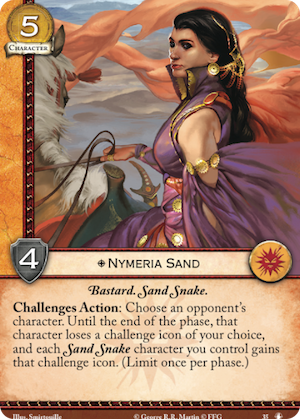 Nymeria Sand
Nymeria Sand
This character will immediately become the centerpiece for a Night’s Watch Banner of the Sun deck and she will make defending the Wall so much easier. Not only is she essentially a “pick an icon” character, but she also denies her opponents icons at the same time. This could really alter the way the Wall is defended and is by far the card I am most excited for in the next few chapter packs.
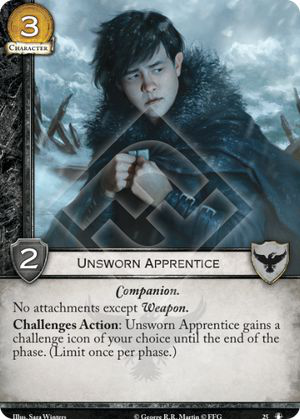
Unsworn Apprentice
Another icon manipulation character? Awesome! Can defend any 1 challenge you want him to. Pairing him with Syrio is going to be a magical combination.
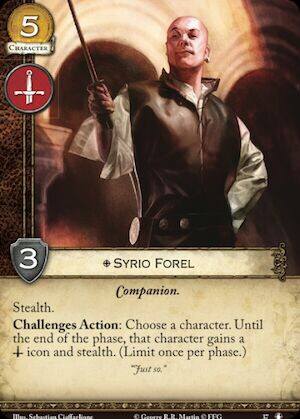
Syrio Forel
Being able to add stealth to any character is nice. Being able to add a military icon is awesome as well. Syrio can train your ravens to peck your opponent’s eyes out and also create another barrier to stealth getting through the Wall.
The King’s Peace (Spoilers)
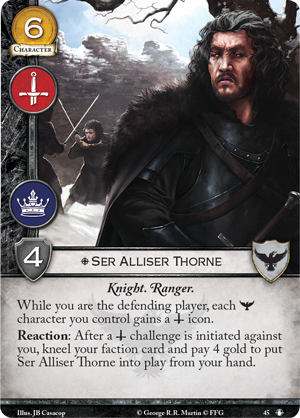
Ser Allister Thorne
Another card that will teach your ravens to peck out eyes. This card has a sort of faux ambush and it makes it very hard to win a military challenge against you; at the very least it guarantees you’ll be able to oppose military. It is a little worrisome that you could save 4 gold and then your opponent can choose not to initiate a military challenge so that you can’t play him, but that could be used as bait as well.
No Middle Ground (Spoilers)
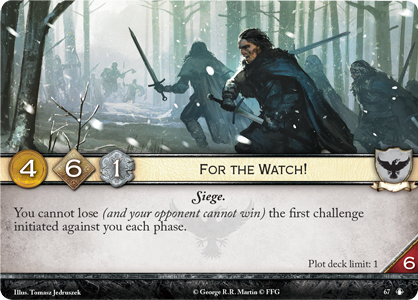
For the Watch
A defensive plot with good gold, good initiative and an effect that can really ruin your opponent’s day if they played A Game of Thrones or Sneak Attack. It also makes Old Bear’s ability slightly easier to trigger and makes it so that you only have to defend 2 challenges that turn rather than 3 (assuming they don’t have a card that gives them a 4th challenge that turn)
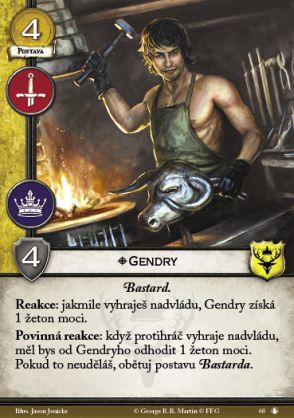
Gendry
Baratheon Character, 4 Gold, MIL POW, 4 STR, Non-Loyal
Bastard.
Reaction: After you win dominance, Gendry gains 1 power.
Forced Reaction: After an opponent wins dominance, you may discard 1 power from Gendry. If you do not, sacrifice a Bastard character.
Gendry
This is a little shagga, but I can’t help but look forward to a deck that is based on Chamber of the Painted Table, Iron Throne and Gendry. Lots of power at dominance and you can sacrifice bastards in hiding if you end up losing dominance somehow. Could become a very boom or bust deck, but would likely be very entertaining to play. Or frustrating. One of the two.
True Steel (Spoilers)
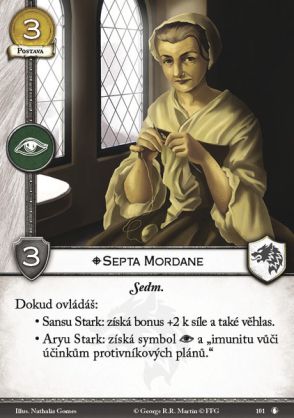
Septa Mordane
Stark Character, 3 Gold, INT, 3 STR, Non-Loyal
The Seven.
While you control:
– Sansa Stark: she gets +2 STR and Renown.
– Arya Stark: she gets an intrigue icon and “immune against opponents’ plot effects.”
Septa Mordane
Septa Mordane gives Sansa +2 strength and renown and Arya an intrigue icon and immunity to opponent’s plots. That means Arya is a stealth tricon as long as she has a dupe and Sansa is a 4 strength bicon who gains a power when she stands and a power when she wins a challenge. Very good for both characters.
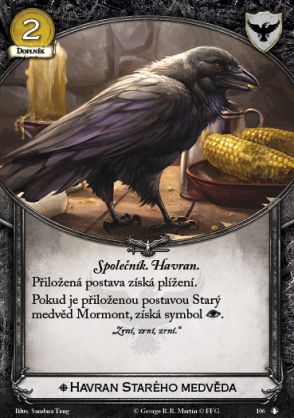
Old Bear’s Raven
Night’s Watch Attachment, 2 Gold, Non-Loyal
Raven. Companion.
Attached character gains stealth.
If attached character is Old Bear Mormont, he gains an intrigue icon.
Old Bear’s Raven
Attachable stealth is very nice. It doesn’t specify that it has to be a Night’s Watch character, so that makes it better. Making Old Bear a stealth tricon who doesn’t kneel to defend when the Wall is out? Amazing.
Wolves of the North (Spoilers)
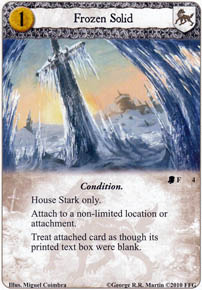
Frozen Solid
There are some locations that are very hard to get around. Plaza of Punishment is very dangerous against a low cost deck that the Night’s Watch typically enjoys running. Being able to blank the Plaza of Punishment, or a draw location or even an opponent’s Iron Throne so that your Iron Throne wins you dominance are all very nice effects.
Thank you for taking the time to read this article. I hope you enjoyed reading all my thoughts about the Night’s Watch. We will continue to churn out articles, videos, podcasts and blogs about A Game of Thrones LCG 2.0 Edition, so if you have any suggestions or comments how to improve the site, content or have a topic you’d like to hear about, feel free to comment below, or email us.



